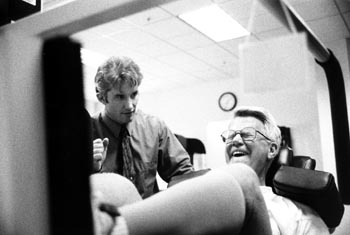Slow and Easy
Feeling the Burn: Trainer Hans Roth, left, prompts lifter Jim Price.
Seniors finding fast results from super-slow lifting
By Dylan Bennett
AT 77, BETTYLOU SUTTON, a retired homemaker from Glen Ellen, looks beautiful and feels even better. Her wispy tangerine hairdo, shiny round silver earrings, and light blush lipstick accent a broad smile and twinkling eyes. Sutton's good humor belies her recent encounter with breast cancer and the rigors of radiation treatment. Thankfully, the hard times are behind her, partly because she has a dynamic new hobby: weightlifting.
But the exercise that gives Sutton more in common with Arnold Schwarzenegger than her bridge-playing peers is not your typical back-breaking affair with a pile of hefty steel donuts. Sutton is a pioneer in the area of super-slow resistance training, a trend in exercise that achieves tremendous results for seniors, busy professionals, and anybody seeking greater physical strength while avoiding injury, unrealistic time commitments, and the intimidating gym scene.
"I came in here hunched over and shuffling. I was always tired," says Sutton. "I couldn't stand up straight. In about three weeks I started feeling better, and I've progressed ever since. I lost 14 pounds without dieting. I didn't even want to eat. Before, my posture was terrible. We seniors get this hump in our backs, and it just went away."
"Now I can go all day from morning till night. It's incredible."
In a fast-paced information society, resistance training weighs in as one of those things in life--like playing the slide guitar, drinking vintage wine, spending an amorous afternoon, or working for the bomb squad--that's better done slowly. In Santa Rosa, about a dozen personal trainers--including Darren Howey at Parkpoint Club and Hans Roth, owner of Fitness Intelligence Training (FIT)--preach the blessings of super-slow lifting. They recommend the regimen for clients who want to work out intensely, safely, and efficiently.
Roth's gym specializes exclusively in super-slow under the guidance of a personal trainer, offering a quiet, almost clinical, atmosphere with cozy Nautilus machines and soft classical music.
"Super-slow is the next advancement in exercise," says Roth, "just like big leaps in medicine and computers and cars."
Super-slow techniques derive from the Nautilus tradition of slow-lifting on sophisticated weight machines that use oblong cams to create variable resistance. According to Roth, an osteoporosis study at University of Florida medical school at Gainesville found extra slow-weight training dramatically increased muscle strength in old people.
That discovery and a subsequent self-book titled Super-Slow: The Ultimate Exercise Protocol by Ken Hutchins, an exercise innovator and Nautilus veteran, put the "slow" in super-slow and established the technique's reputation for safety.
"There's an element of control with this that is vitally important," suggests Howe. "If you don't have that control, the scary part is you can really damage your body."
Dr. James Price, a Santa Rosa cardiologist and FIT client of super-slow, says injuries in the knees and other joints often come from a lack of supportive muscle. As well, some body types don't change much in size, only in their ratio of muscle to fat. Thus, muscle gain brings weight loss. He credits the program for his trimmer figure and better health that allowed him to stop blood pressure medication.
"It helps you stay young and arrests the aging process to some extent, by maintaining reasonable muscle strength," explains Price. "You don't get that from most aerobic exercise. You can get strong legs, but that's not going to help your rotator cuff, your quads that help support your knees, lower back, and things like that."
Ironically, pumping iron in slow motion is perfect for busy people. The super-slow "protocol" of taking 10 seconds to raise a weight and five seconds to lower it requires only a brief--but intense-- session in the gym. Strength is gained by fatiguing a muscle to the failure point, something that occurs quickly with super-slow lifting.
"It's short, sweet, and to the point," says Parkpoint's Howey.
Poetically, success comes with the failure to go on, rather than pushing for a maximum weight.
A good slow workout includes one uncomfortable ingredient: pain. By the eighth repetition a tiny weight fills muscles with a searing hot burning sensation. "These are masochistic people," says Howey. "They are feeling pain."
For this reason, super-slow lifting for many requires the coaching and encouragement of a personal trainer.
Getting started can mean a six-week, $300 investment.
While the pain is intense, it's possible to train without the acute soreness normally associated with weightlifting. "I never once had sore muscles," exclaims Sutton. "This is the feel-good place," she says, looking around the FIT gym. "And I'm happier than I was before."
For Price, who works long hours, the efficiency counts. "It's kind of hard to go out and bike and jog," says Price.
"If you do a good hard 30 minutes with super-slow, that's a good workout."
[ Sonoma County | MetroActive Central | Archives ]
Copyright © Metro Publishing Inc. Maintained by Boulevards New Media.
![]()

Michael Amsler
From the January 15-21, 1998 issue of the Sonoma County Independent.
![[MetroActive Features]](/gifs/feat468.gif)